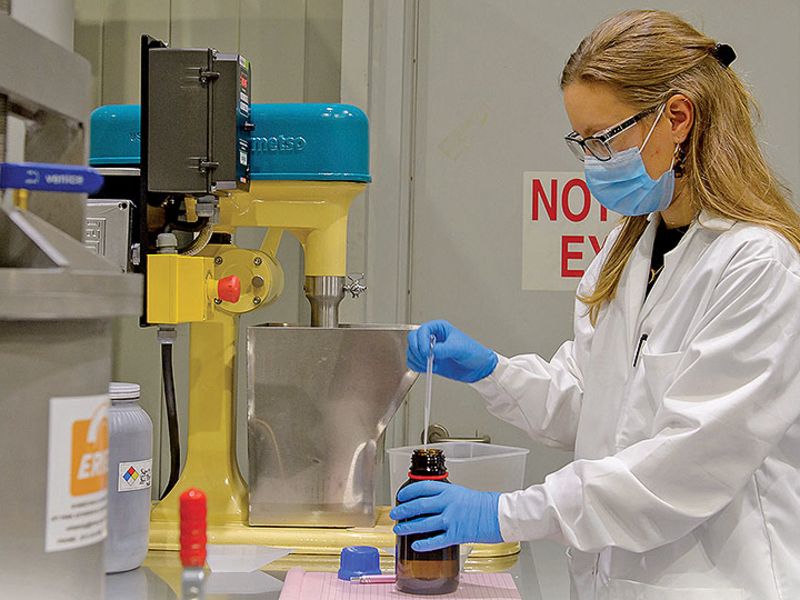
Profit is not a dirty word in EV-battery recycling. In fact, Jessica Durham, a materials scientist at Argonne National Laboratory, says it’s key, just as it is in traditional vehicle and 12-volt lead-acid battery recycling.
“To be able to recycle EV batteries, there’s going to have to be some type of profit,” said Durham. “Or else people are not going to want to do it. And the more profit we have, the more people will be willing to adopt this technology.”
Argonne’s researchers say they’ve found an old mining process that cuts down the cost of processing used batteries and preserves their high-priced metallic compounds, unlike traditional methods that break them down into their lower-cost constituent parts. This clever new methodology has caught the interest of battery makers and the auto companies that use these recycled materials.
The recycling of lithium ion batteries has yet to scale up. Only about 5 percent are recycled. Today most find secondary lives repurposed for things such as solar home-energy storage.
In this newly surging era of electric vehicles, profit from recovered battery-scrap materials is super critical to the sustainable success of the auto marketplace. These materials are either in short supply or will shortly be in tight supply. And in many cases, mining these materials damages the environment and exposes workers to hazardous substances.
Currently, there are two main, energy-intensive — and costly — EV-battery recycling processes: pyrometallurgy and hydrometallurgy. The former burns the shredded battery to separate materials, and the latter soaks it in strong acid baths to dissolve out costly metals. But resynthesizing these metal compounds, once broken all the way down into their raw constituent materials, adds greatly to their costs.
Durham and her associates at the suburban Chicago lab, which is part of the U.S. Department of Energy, are advocating a “direct” recycling method called froth flotation, previously used in mining for the purification of ores. This separates metal-intensive cathode (negative electrode) compounds intact in water baths with reagents. These reagent baths use recycled water as their base. The reagent chemicals selectively react with the surface of one material to allow it to float in solution, letting the other one sink. And by selectively affecting one or the other, the two materials can be separated and recovered with good purity.
Durham says her project focuses on the cathode, vs. the battery’s anode or electrolyte, because that is where most of the battery’s value resides, particularly with many makers’ high concentrations of precious cobalt.
“The direct recycling pathways we’re using help to make recycling more profitable,” she said. “It’s called direct recycling because we’re trying to reuse the materials directly, without breaking them down all the way into raw materials.”
In less than a decade, researchers project that 2 million tons of end-of-life EV batteries will need to be recovered and recycled — each year. Obviously, the number of lithium ion EV batteries to recover is relatively low today. But that is going to change substantially. And experts say the recycling infrastructure is not ready to handle that, particularly with today’s low battery-recycling profitability.
One of Argonne’s most important research partners, according to Durham, has been Michigan Technological University in Houghton. Its early work on the froth flotation process is the foundation for current research, technical demonstrations and scaling exercises. It is what will be used to separate the diverse mixtures of lithium oxides in older, newer and various maker batteries. Currently, these include lithium cobalt oxide, lithium manganese cobalt oxide, lithium nickel cobalt aluminum oxide and lithium iron phosphate. Durham says that manufacturers keep adjusting their recipes for cathodes to improve safety and power. All of this adds a layer of complexity.
“The reason we’ve chosen froth flotation is that it’s really simple to operate,” said Durham. “And it’s really simple to put these steps or processes together to get this nice, high-purity separated material. Sometimes if separation is challenging, you may have to run it through a tank two or three times to get high-grade battery-purity material, over 99 percent pure.”
Separate research also is going on at Argonne to examine how various kinds of batteries are made and assembled and which are easier and less expensive to disassemble.
That’s because batteries that are easier to break down chemically and mechanically cost less, helping to make the EV future cleaner and less costly.

